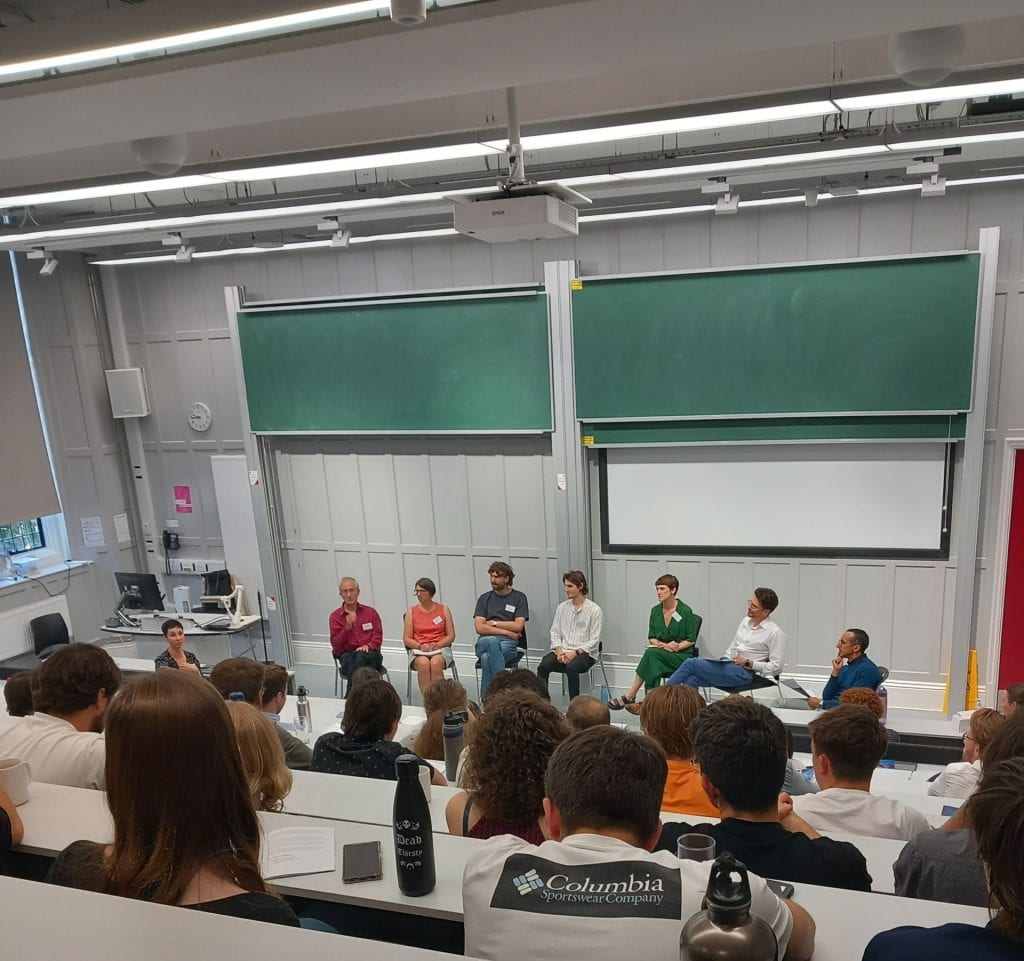Category: Events
David Greenwood: DataScience@work seminar
Kew Gardens: DataScience@work seminar
Microsoft Research: DataScience@work seminar
Advai: DataScience@work seminar
Student perspectives: Compass Annual Conference 2023
A post by Dominic Broadbent, PhD student on the Compass CDT, and Michael Whitehouse, PhD student of the Compass CDT (recently submitted thesis)
Introduction
September saw the second annual Compass Conference, hosted in the Fry Building, the home of the School of Mathematics. The event was particularly special as it is the first time that all five Compass cohorts were brought together, and it was a fantastic opportunity to celebrate the achievements and research of the Compass CDT with external partners. This year the theme was “Communicating Research in Context“, focusing on how research can be better communicated, and the need to highlight the motivation and applications of mathematical research.
Research talks
The day began with four long form talks touching on the topic of communicating research. Starting with Alessio Zakaria’s talk which delved into Hypothesis tests, commenting on their criticial role as the defacto statistical tool across the sciences, and how p-hacking has led to a replication crisis that undermines public confidence in research. The next talk by Sam Stockman and Emerald Dilworth discussed the challenges they faced, and the key takeaways from their shared experience of communicating mathematics with researchers in the geographical sciences. Following this, Ed Davis’s interactive talk “The Universal Language of Visualisations” explored how effective visualisation techniques should differ by the intended audience, with examples from his research and activities outside of academia. The last talk by Dan Milner explored his research on understanding the effect of environmental factors on outcomes of smallholder farmers in Kenya. He took us through the process of collecting data on the ground, to modelling and communicating results to external partners. After each talk there was an opportunity to ask questions, allowing for audience participation and the sparking of interesting discussions. The format mirrored that which is most frequently used in external academic conferences, giving the speakers a chance to practice their technique in front of friendly faces.
Lightning talks
After a short break, we jumped back into the fray with a series of 3-minute fast-paced lightning talks. A huge range of topics were covered, all the way from developing modelling techniques for the electric grid of the future, to predicting the incidence of Cerebral Vasospasm at the Southmead Hospital ICU. With such a short time to present, these talks were a great exercise in distilling research into just the essentials, knowing there is very limited time to garner the audience’s interest and convey an effective message.
Special guest lecture
After lunch, we reconvened to attend the special guest lecture. The talk, entitled Bridging the gap between research and industry, was delivered by Ruth Voisey, CEO of the Smith institute. It outlined Ruth’s journey from writing her PhD thesis ‘Multiple wave scattering by quasiperiodic structures’, to CEO of the Smith Institute – via an internship with the acoustic research team at Dyson. It was particularly refreshing to hear Ruth’s candid account of her ‘non-linear’ rise to CEO, accrediting her success to strong principles of clear research communication and ‘mathematical evangelicalism’.
As PhD students in the bubble of academia, the path to opportunities in the world of industry can often feel clouded – Ruth’s lecture painted a clear picture of how one can transition from university based research to a rewarding career outside of this bubble, applying such research to tangible problems in the real world.
Panel discussion and poster session
The special guest lecture was followed by a discussion on communicating research in context, with panel members Ruth Voisey, David Greenwood, Helen Barugh, Oliver Johnson, plus Compass CDT students Ed Davis and Sam Stockman. The panel discussed the difficulty of communicating the nuances of research conclusions with the public, with a particular focus on handling these nuances when talking to journalists – stressing the importance of communicating the limitations of the research in question.
This was followed by a poster session, one enthusiastic student had the following comment “it was great to see of all the Compass students’ hard work being celebrated and shared with the wider data science community”.

Concluding remarks
To cap off the successful event, Compass students Hannah Sansford and Josh Givens delivered some concluding remarks which were drawn from comments made by students about what key points they’d taken from the day. These focused on the importance of clear communication of research throughout the whole pipeline, from inception in discussion with fellow academics to the dissemination of knowledge to the general population.
The day ended with a walk to Goldney Hall, where students, staff, and attendees enjoyed delicious food, wine, and access to the beautiful Orangery gardens.
Compass Guest Lecture: Dr Vincenzo Gioia and Prof Ruggero Bellio
Special Guest Lecture: John Burn-Murdoch
Compass Conference 2022
Our first Compass Conference was held on Tuesday 13th September 2022, hosted in the newly refurbished Fry Building, home to the School of Mathematics. (more…)

